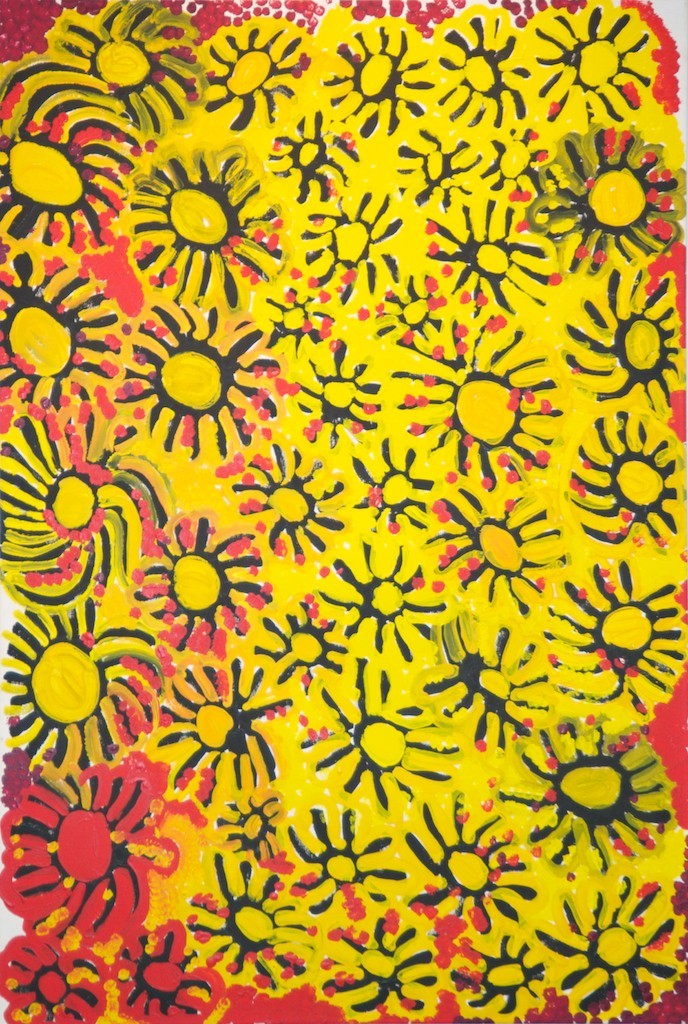
And a great artist.
Lorna Fencer Napurrurla, according to Chips Mackinolty, chairman of ARTBACK, the NT’s underfunded but-still-great-for-it visual arts touring agency, was the “most wonderful and marvellous ratbag of the Warlpiri Nation.”
She was non-conformist, original (and) abandoned conventions.
She was revolutionary, independent, mercurial, unrelenting, tough, funny, flirtatious (and) seriously dedicated.
She was go it alone, irreverent, talented, energetic, confident, irascible, feisty, loud, imperious, cranky and her imperial majesty.
She was prolific, chaotic and partial to intellectual stoushes.
…
She was wicked, impish, forcible and would brook-no-opposition.
She was a dab hand at getting others to do her bidding, tough, overbearing, born-to-rule, with a strong sense of self belief, a strong sense of self worth.
She was bossy, wicked, (with a) rapier sharp wit.
She was a loner, eccentric, individualist, over the top fearless, go it alone, against the grain, (and) very, very funny.
That was Chips speaking at the opening of Yulyurlu, a retrospective that opened at the Chan Contemporary Art Space during the Darwin Festival in August this year.
Yulyurlu opens at the ANU’s Drill Hall Gallery tomorrow (Thursday 10th) night. If you are in the big C it’ll be your loss if you don’t get along to see this show.
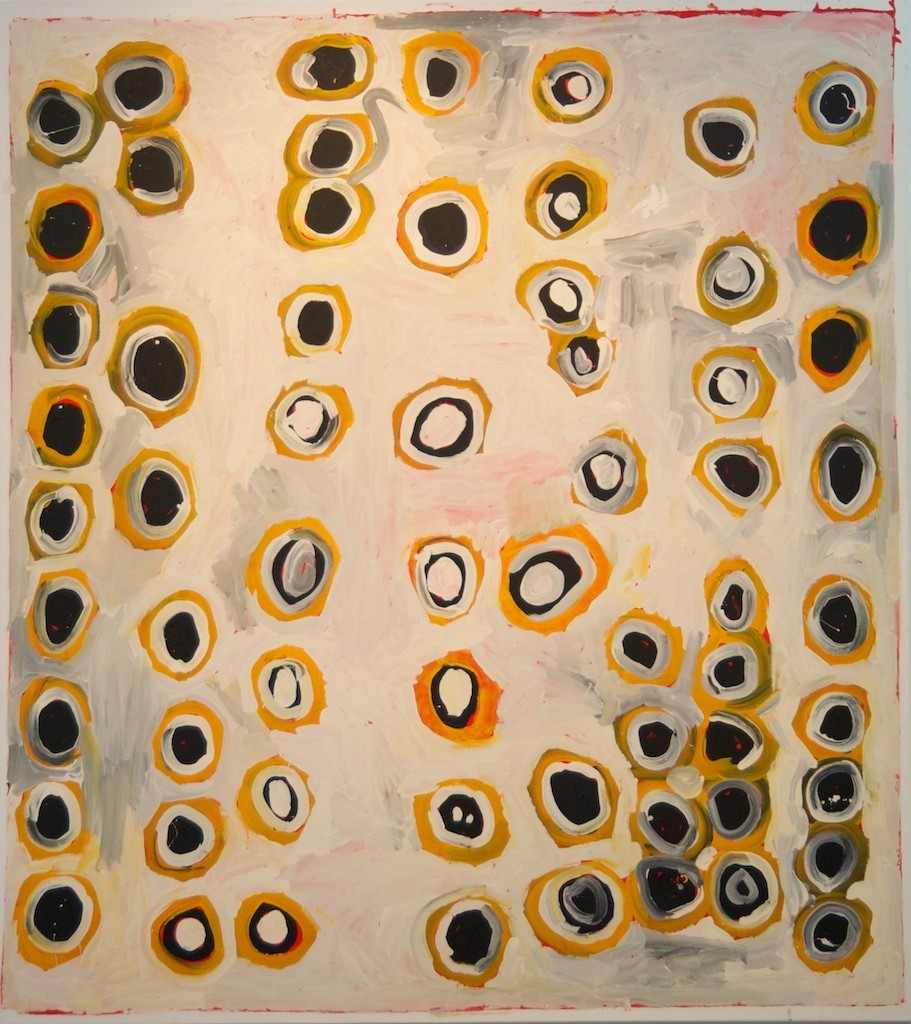
Yulyurlu is a truly wonderful show that – if the accepted norms of retrospectives of contemporary Australian artists were applied – should be an abject failure.
On my first visit to this show I came away distinctly underwhelmed. A few great paintings, a few doo-dads and more than a few ordinary examples of her work. I went back with a camera and fell a little deeper in love with the great works, understood the mundane a little better and continued to be disappointed with much of the show.
Then I got a copy of the catalogue. That called me back for a third time and then Yulyurlu began to make some sense.
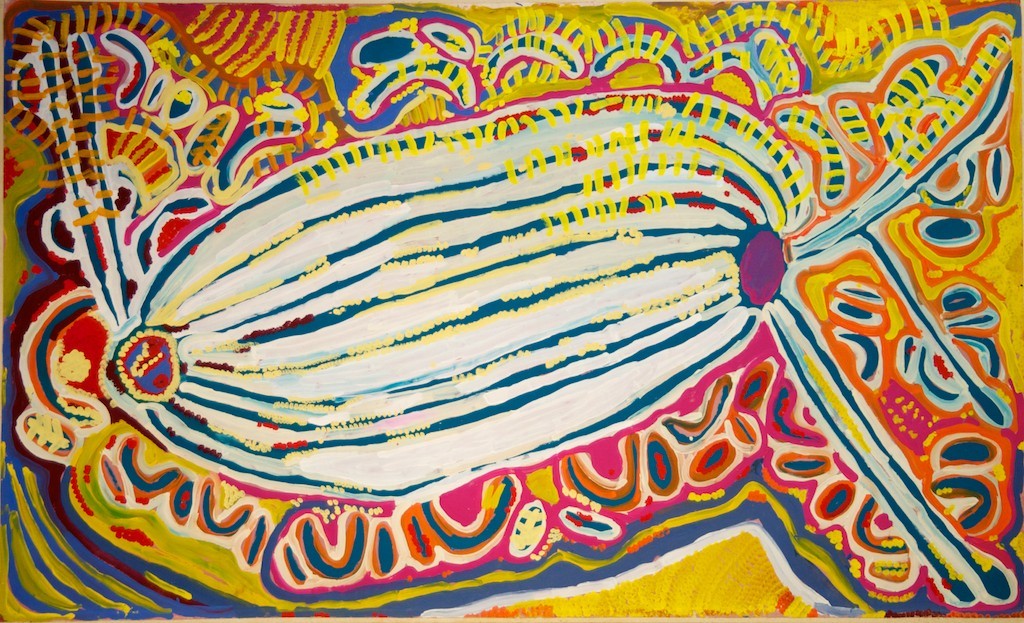
Why and how so?
Firstly, this show rewards a repeated visit or three. Second, you need to read the catalogue and thirdly you need to realise that this is no best-of show. What it is is a brutally frank exposition of the life and career of a national treasure who didn’t practice her art, she lived it. See the show – three or four times – and get and read the essays in the wonderful catalogue.
Like Chips Mackinolty I can’t gush about art or artists as too many can and so tediously do. Paintings don’t “shimmer” or “glow” for me, though many of the works in this show burst off the wall with a physical or emotional force that a photograph just cannot capture.
And I won’t weave fantastic tales about the artist’s passing foretold or stretch a wafer thin veil of sanctity and cultural purity across her life.
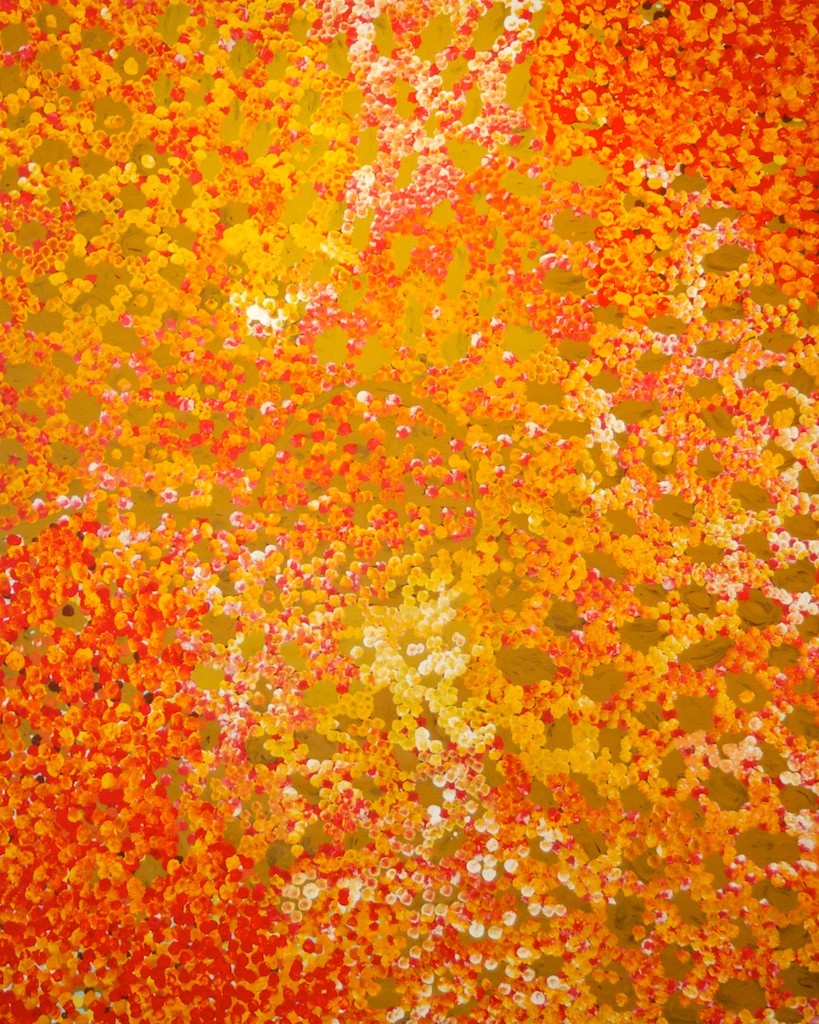
If you walk into Yuyurlu expecting to only see Lorna’s greatest works, like me you will most likely come away disappointed. But, if you go to this show to see an artist at work – scratching for a dollar from wherever it will falls, always painting, painting, painting – then you will be rewarded in no short measure.
In her marvellous catalogue essay Barbara Amberg Pederson – who worked closely with Lorna for a number of years at the Mimi Arts cooperative based in Katherine – describes life with Lorna:
Lorna was a fiercely independent artist. She painted for anyone who would supply her with paint, brushes and something to paint on. She was driven to repeat, over and over, the stories of her ancestral Jukurrpa. Because of this, her work was prolific … She was moderately successful in her time, with various respected galleries demanding her work, as too, most unfortunately, did many unscrupulous persons. These people abused her friendly and magnanimous nature, treating her unethically, meanly and often very shabbily in their quest to take her treasures away with them. The old ‘whisky, red beads and mirrors‘ currency was very prevalent in the early part of the last decade.
Not that Lorna was entirely innocent in all this. Barbara Amberg Pederson again:
Lorna delighted in the drama, and the comedy, of the sometimes physically aggressive tussles over who was to ‘have her.’ So many different people skirmished for the opportunity to have her paint for them. Not only were there the local backyard entrepeneurs; after the wet season nameless people would travel into town from far-off places in station wagons or four-wheel drives laden with canvas, paint and brushes, seeking out Lorna and other Aboriginal artists.
Chips Mackinolty first met Lorna 30 years ago at her home at Lajamanu – 500 kilometres to the south-west of his then base at Mimi Arts in Katherine, a town where racial tensions have never been far below the surface.
Then as now art and culture from the bush occasionally unite in impressively powerful political conjunction. One year the local pub, notorious for banning ‘full-bloods’ from the front bar was cursed by massed ranks of dancers and singers from the Arnhem hinterlands east of Katherine. Another year the Warlpiri came to town in numbers and with undeniable force and cultural power.
The sight of twenty men in full ceremonial attire – hair string headdresses, ochre and down body decorations, leaves strapped to calves – followed by thirty bare-breatested, painted Warlpiri women moving down Katherine Terrace was astonishing. The pounding street echoes of boomerangs clapping were as striking and powerful as anything I’ve witnessed. You don’t mess around with the Warlpiri – a fact that was on display, big time.
One of those women was Lorna. Later that night Chips arrived back at his Sydney Williams Hut (drop into ‘the best house in First Street’ he told me in the early while I was in Sydney thinking about heading north) to witness:
…half a dozen older women singing and driving off a young, drunken man, armed with just their voices and yukurrukurru (dancing boards), thrust in front of them. The man fled. At about the same time one of the Warlpiri women slipped a bloody knife to me, which I managed to back-pocket as quickly as I could. Another man was lying on the ground, surrounded by wailing women.
At the opening of the show Chips asked his audience a question:
So what sort of person was Napurrurla?
She was an artist, we know that: that’s why we are here.
But in no way was she some sort of ethereal, starry-eyed art-for-art’s-saker. She created her work for a living, for her, her family and for her countrymen and women. Living in the Top Camp at Lajamanu or at times fairly rough in places in Katherine or Bagot was no bed of roses. It was not the romantic life of the artist of Montmartre: it was tough, often a life of tragedy, largely one of hardship. It was a life that was both intensely communal and at times very lonely.
Yes, she was an artist, she lived through hard times and good times but above all she was Lorna Fencer Napurrurla wonderful, irascible and wicked.
The hard times that Lorna Fencer Napurrurla faced in her life are best illustrated by the one painting that has no dots, no Jukurrpa, no ancestral beings. Just the unalloyed grief of a mother poured onto canvas in a fury following weeks in the sorry camp after the death of her son. For mine this is one of – if not the most – powerful paintings in the show.
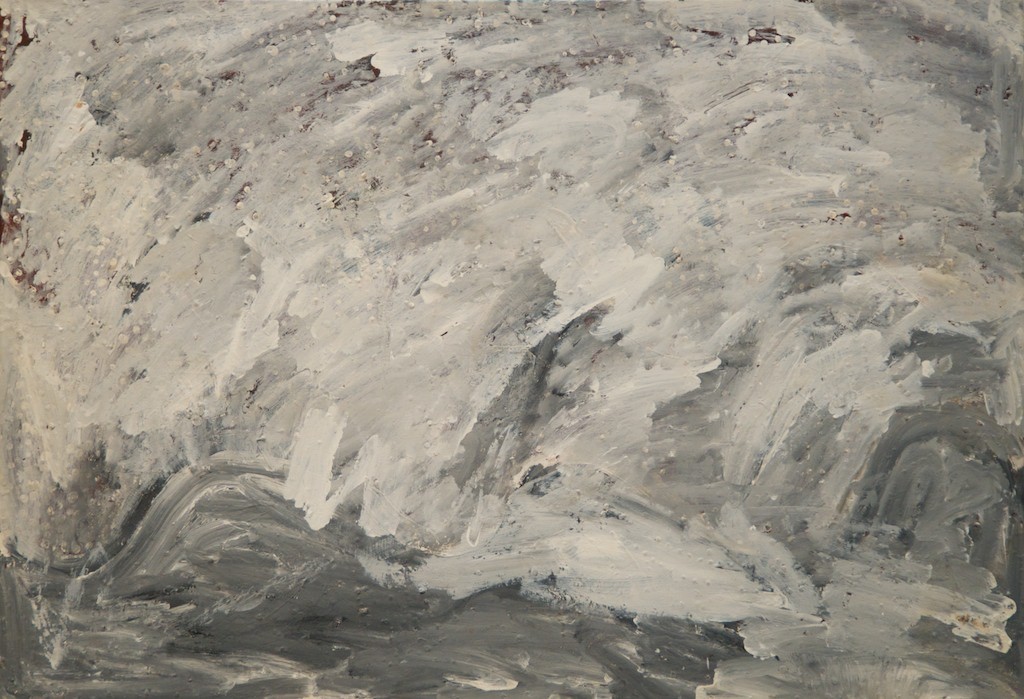
Yulyurlu opens at the ANU’s Drill Hall Gallery, Kingsley Street Acton in the ACT this Thursday 10 November 2011 at 6 pm and runs to 18 December. The Drill Hall is open Wednesday to Sunday 12-5pm.
From there Yulyurlu goes to the Flinders University City Art Gallery in Adelaide from 13 April to 26 May 2012; then to the RMIT Art Gallery, Melbourne from 29 June to 25 August 2012; the Bathurst Art Gallery in NSW from 28 September through 18 November 2012; the Noosa Arts Gallery, Tewantin QLD from 29 November 2012 to 20 January 2013 and finally to Artspace Mackay, Mackay QLD from 1 February to 17 March 2013.
You can also find out a lot more about Yulyurlu the show and the life of Lorna Fencer Napurrurla – including Yulyurlu Education Kits for Lower Primary, Lower Secondary and Upper Secondary students; Research Notes; an Artists Profile and photos, notes from the Exhibition Opening at the Chan Art Space in Darwin in early August 2012 and more at the ARTBACK website.
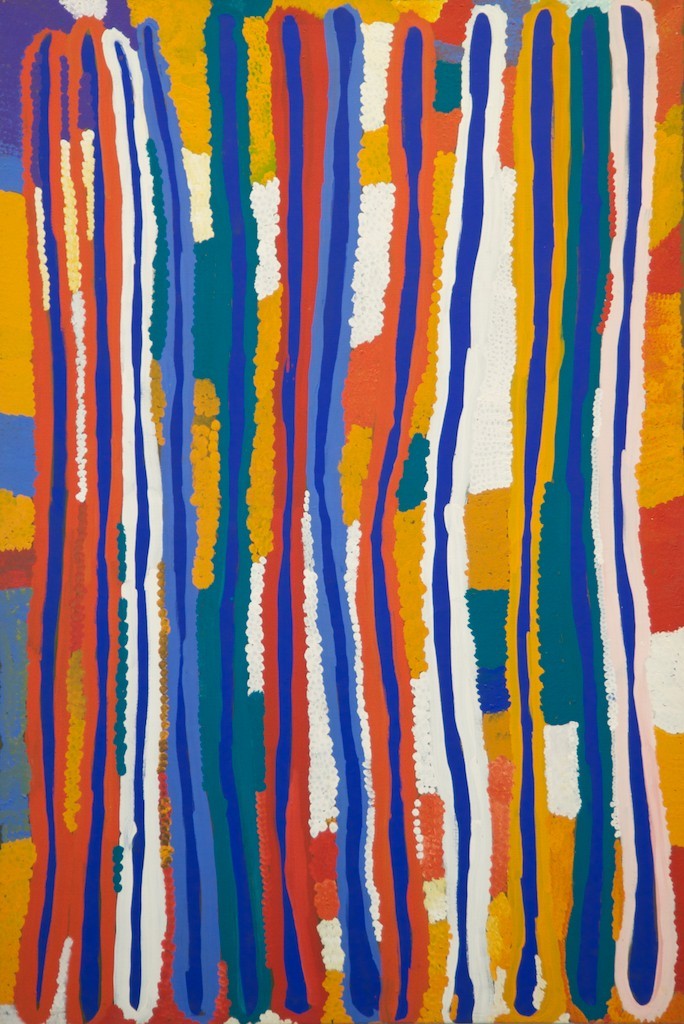
Postscript: I don’t want to poke sharp sticks under anyone’s fingernails but I hope that by the time this show is hung at the Drill Hall that someone works out which way is up.
When I started looking at the photos for this post I noticed that several paintings were presented very differently in the catalogue than in the show. On my count the following paintings were upside-down in either the catalogue or on the wall: “Wapirti (White Bush Potato), 2002; Yarla, Yam, 1992; Digging Sticks and Bush Tucker, 2001; Summer Yam (Wapirti, Little Bush Potato) c. 1999; Boomerang, 1998; My Country, c. 1997; Untitled (Yam) 2000 and Kangaroo Tucker, 2000.
Post-postscript: As indicated above, Lorna Fencer Napurrurla was indeed a prolific artist. Five years after her passing you can still see – and buy – lots of her work on-line – see for example the Central Art – Aboriginal Art Store; the Aboriginal Art Coop Gallery; Coo-ee Aboriginal Art Gallery; Muk-Muk Fine Art and the err..interestingly named Original and Authentic Aboriginal Art site.







Crikey is committed to hosting lively discussions. Help us keep the conversation useful, interesting and welcoming. We aim to publish comments quickly in the interest of promoting robust conversation, but we’re a small team and we deploy filters to protect against legal risk. Occasionally your comment may be held up while we review, but we’re working as fast as we can to keep the conversation rolling.
The Crikey comment section is members-only content. Please subscribe to leave a comment.
The Crikey comment section is members-only content. Please login to leave a comment.